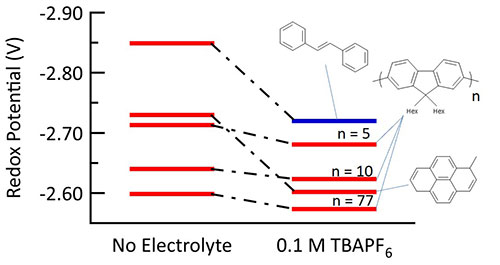- Home
-
Research Groups
Division Groups
- Artificial Photosynthesis
- Catalysis: Reactivity & Structure
- Electrochemical Energy Storage
- Electron- and Photo-Induced Processes for Molecular Energy Conversion
- Neutrino and Nuclear Chemistry
- Surface Electrochemistry and Electrocatalysis
Associated Groups
- Catalysis for Alternative Fuels Production
- Nanostructured Interfaces for Catalysis
- Structure and Dynamics of Applied Nanomaterials
- People
- Operations
- News
- Events

Electron- and Photo-Induced Processes
Toward a universal method for true redox potentials

A novel method to determine redox potentials without electrolyte is presented. The method is based on a new ability to determine the dissociation constant, K°d, for ion pairs formed between any radical anion and any inert electrolyte counterion. These dissociation constants can be used to determine relative shifts of redox potential as a function of electrolyte concentration, connecting referenced potentials determined with electrochemistry (with 0.1 M electrolyte) to electrolyte-free values. Pulse radiolysis created radical anions enabling determination of equilibrium constants for electron transfer between anions of donor and acceptor molecules as a function of electrolyte concentration in THF. The measurements determined “composite equilibrium constants”, KeqC, which contain information about the dissociation constant for the electrolyte cations, X+, with the radical anions of both the donor, K°d (D–•,X+) and the acceptor, K° d(A–•,X+). Dissociation constants were obtained for a selection of radical anions with tetrabutylammonium (TBA+). The electrolyte was found to shift the reduction potentials of small molecules 1-methylpyrene and trans-stilbene by close to +130 mV whereas oligo-fluorenes and polyfluorenes experienced shifts of only (+25 ± 6) mV due to charge delocalization weakening the ion pair. These shifts for reduction of aromatic hydrocarbon molecules are smaller than shifts of +232 and +451 mV seen previously for benzophenone radical anion with TBA+ and Na+ respectively where the charge on the radical anion is localized largely on one C═O bond, thus forming a more tightly bound ion pair.
Phys. Chem. A., 2020, 124, 5487 DOI: 10.1021/acs.jpca.0c02948




